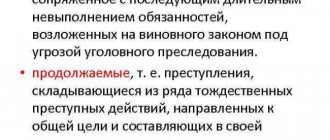Tweet
Investigative and judicial practice faces difficulties in distinguishing the complexity of repetition, that is, the real totality of crimes from ongoing crimes. This is caused by the similarity of objective signs of repeated crimes and a continued crime. In addition, the explanations of the RF Court of Appeals for various categories of cases are not always uniform.
The Criminal Code of the Russian Federation does not define a single continuing crime. It is only in the theory of criminal law and in paragraph 2 of the PPVS of the USSR dated 03/04/1929 No. 23, as amended on 03/14/1963. These clarifications of the Supreme Court indicate that continuing crimes consist of a number of identical criminal actions aimed at a common goal and collectively constituting a single crime. All episodes of a continuing crime are united by a single intent that arose before the commission of the crime. Repeated crimes are committed each time according to a new intent.
The interpretation of a continuing crime, its delimitation from the totality of crimes, was the subject of consideration by the ECHR in the case of Rohlena v. the Czech Republic (ruling of January 27, 20151, complaint No. 59552/08). It notes that the concept of a continuing crime occupies a central place in the system of European law on the issue of plurality of crimes and is the “grammar of criminal law.” The applicant, accused of repeatedly inflicting physical and mental violence on his wife, complained that he had been found guilty of a continuing offense involving acts committed before they became criminal offenses.
The ECtHR, when interpreting the legislation of the Czech Republic, referred to the concept of “continuous crime”, recognizing that it consists of separate acts united by a common purpose, constituting the same crime. A continuing crime should be considered a single act, and its legal classification should be carried out in accordance with the law that was in force at the time the last episode of the crime ended.
From this ruling of the ECHR it follows that the acts are related in that they are carried out in the same way and pursue the same goal. The necessity of proximity of individual acts in time is presumed. However, this factor must be considered taking into account the circumstances of each case, without predetermined deadlines. Individual acts may be so interconnected that they indicate the continuous existence of external circumstances favorable to the commission of crimes and a general criminal intent. Moreover, individual acts must be united by a common criminal purpose in the sense that the renewal of the criminal's intent can be determined by external circumstances favorable to the commission of the crime.
Main signs of a continuing crime
The Decree of the PVS of the USSR dated March 4, 1929 No. 23 provides a definition of a continuing crime. The Sun identifies three of its characteristics:
- committing several acts;
- the identity of these acts;
- unity of purpose.
Thus, a continued act is one crime, although consisting of a combination of several. And it must qualify under one article of the Criminal Code of the Russian Federation. The signs of a continuing crime are a guide for the court in determining the key points of the subjective side of the act. Depending on the nature of the crime, these basic signs may be supplemented with optional ones.
Qualification of theft: single continuous or aggregate?
So, my living example from the case as intended.
A person, let's call him G., walks down the street to an appointment at the clinic and finds a woman's handbag left unattended. He looks into it, takes out a wallet, takes the wallet for himself, throws the bag, and leaves.
After the doctor’s appointment, G. takes out a wallet from his pocket, we see cash there in the amount of 2800 rubles (he takes it out and puts it in his pocket), and several cards, one of which is a bank card.
After that, he takes a bank card, throws out his wallet, and starts shopping, paying with the card and cash (he used the cash to buy shoes for his son).
The card is used to pay until the bank blocks it at the request of the victim.
The investigation qualifies G.’s actions under paragraph “g.” part 3 art. 158 of the Criminal Code of the Russian Federation as a single ongoing crime with total damage of 6.4 thousand rubles, significant for the victim, including 2.8 thousand in cash, the rest was stolen by debiting from a card in stores.
It is obvious that G. could not have stolen the 2800 rubles in cash in his wallet from a bank account...
Let's take a break from G. and look at a fresh example from an over-fair continuous cassation.
“Based on the circumstances presented in the indictment, the court found in its verdict that on August 27, 2022, from 11 p.m. 30 min. until 11 p.m. 35 min. I., while in the apartment <data taken>., took advantage of the fact that <data taken> was sleeping and not watching his actions, from the countertop of the kitchen set he secretly stole a credit bank card of Sberbank of Russia PJSC attached to the current account, opened in the name of <data seized>., and a piece of paper with the PIN code of this card, after which he left the apartment and made 4 operations to withdraw cash from the card at different ATMs, for a total amount of 126,000 rubles, causing damage to PJSC Sberbank of Russia material damage in the specified amount.
In addition, I. was found guilty of the fact that on the same day, from 11 p.m. 35 min. until 11 p.m. 40 minutes, while in the same apartment, he secretly stole a tablet computer <data taken> from the kitchen table, causing damage in the amount of 14,500 rubles.
These actions of I. were qualified by the court as a combination of two crimes provided for in paragraph “g” of Part 3 of Art. 158 of the Criminal Code of the Russian Federation and Part 1 of Art. 158 of the Criminal Code of the Russian Federation, respectively.
It does not follow from the indictment documents in the case that I. stole the tablet computer <data taken> out of new intent.
The bank card <data seized> and his tablet computer were stolen by the convicted person in one place, one after another, under the same circumstances, and, in fact, the stolen property left the possession of one person.
The infliction of material damage to various victims by these actions has no legal significance, since I. committed one action aimed at unlawfully taking someone else’s property.
Under such circumstances, the qualification of the actions of the convicted person under two elements of crime provided for by different parts of one article of the Criminal Code of the Russian Federation cannot be considered correct, and the judicial panel finds it unnecessary to distinguish the theft of property <data taken> into an independent crime.
This error must be corrected by uniformly classifying all illegal actions of I. established by the verdict as one crime provided for in paragraph “g” of Part 3 of Art. 158 of the Criminal Code of the Russian Federation, which is permissible in the conditions of consideration of a criminal case in accordance with Chapter 40 of the Code of Criminal Procedure of the Russian Federation, since in this particular case the issue of legal assessment of the actions of the convicted person does not require research and assessment of evidence in the case in the general manner.
see - Cassation ruling of the Seventh Cassation Court of General Jurisdiction dated 08/20/2020 N 77-1628/2020 Today the court in G.’s case ruled a guilty verdict, where it absolutely did not substantiate the inconsistency of my arguments that G.’s actions in terms of stealing cash from a wallet in the amount of 2800 rubles must be qualified independently under Part 1 of Art. 158 of the Criminal Code of the Russian Federation, and the theft of the rest of the funds using the victim’s bank card - under “p” of Part 3 of Art. 158 of the Criminal Code of the Russian Federation, excluding from the charge the element “causing significant damage to a citizen.”
I believe that in the above example of the Seventh KSOYU, the conclusion was drawn incorrectly, since the tablet cannot be stolen from a bank account.
I will argue my point of view as follows.
According to the second paragraph of paragraph 16 of the Resolution of the Plenum of the Supreme Court of the Russian Federation dated December 27, 2002 N 29 (as amended on June 29, 2021), continued theft, consisting of a number of identical criminal acts committed by taking someone else’s property from the same source, united by a single intent and collectively constituting a single crime.
The source should be understood not as the owner of the property, but as the place where this property is stored or located.
This may be a rough comparison, but in practice, thefts from nearby sheds, garages, and apartments located on the same site are classified as a totality...
Despite the fact that the court, by its verdict against G., reduced the category of the crime and dismissed the case due to active repentance, in my speech I said that based on the circumstances of the case and the data characterizing G.’s personality, the question of changing the category can be raised in relation to him the crime he committed, and accordingly, the termination of the criminal case on non-rehabilitative grounds, but only if, when bringing charges against him, the provisions of Art. 73 and 220 of the Code of Criminal Procedure of the Russian Federation, that is, when the accusation is correct, justified and corresponding to the factual circumstances of the case.
Considering that G.’s actions were classified incorrectly, there were grounds for returning the case to the prosecutor in accordance with Art. 237 of the Code of Criminal Procedure of the Russian Federation to qualify G.’s actions on two counts of theft.
What do you think, dear colleagues?
Will there be a totality here or is it still possible to steal a tablet from a bank account? Let's talk about it in the comments.
Unity of subject and unity of intent
April 17, 2022 3:34 pm
Lawyers were told how to distinguish a set of crimes from a single ongoing crime
On April 17, during the regular webinar of the FPA RF on improving the qualifications of lawyers, the head of the department of criminal law research of the Russian State University of Justice, Doctor of Law, Professor Yuri Pudovochkin gave a lecture on the topic “Current problems of qualification of a set of crimes”.
He devoted the first part of his speech to the theoretical foundations of the principle of justice underlying the classification of a set of crimes. Yuri Pudovochkin noted that this principle, enshrined both in international law and in Russian criminal legislation, implies the inadmissibility of being held accountable twice for the same crime.
The speaker turned to the ECHR ruling of February 10, 2009 in the case “Zolotukhin v. Russia”, in which the European Court began to develop a comprehensive interpretation of the content of this principle and formulated the following theses: 1) an act can be considered the same regardless of its qualifications; 2) one and the same act can be assessed according to different norms of law, i.e. a combination of various types of crimes is allowed; 3) comparison of signs of offenses is a significant mechanism for deciding whether a set of crimes took place. As Yuri Pudovochkin emphasized, the interpretation of the ECHR is extremely important, since it forms the basis of any qualifying decisions on a set of crimes.
Next, the professor spoke about the evolution of the concept of the totality of crimes contained in Art. 17 of the Criminal Code of the Russian Federation. He said that the current wording of Art. 17 of the Criminal Code of the Russian Federation allows for the recognition of the totality of facts of the commission of identical crimes, in contrast to the wording that was in force until 2003. In this regard, when qualifying crimes, it is necessary to take into account the rules of operation of the criminal law in time and the time of the commission of the crime, but here the courts often make mistakes. Yuri Pudovochkin also drew attention to the fact that due to changes in legislation, an act that was previously classified as a crime may be decriminalized, and the decriminalization of one act may lead to a change in the assessment of the act for a second crime.
In the final part of the lecture, the professor examined the issues of qualification of a set of crimes. Using the example of crimes against two or more persons, he explained that if an article of the Special Part of the Criminal Code of the Russian Federation does not contain a qualifying sign of committing a crime against two or more persons, then the commission of a crime against two or more persons must be classified as a set of crimes, which is confirmed judicial practice.
Another long-standing and complex problem, according to Yuri Pudovochkin, is the delimitation of a set of crimes from a single ongoing crime. According to the speaker, the key features that allow this to be done are unity of subject matter and unity of intent. Regarding how to distinguish a set of crimes from the sequential execution of stages of a crime, Yuri Pudovochkin explained that the sequential execution of stages of the same crime does not mean a set of crimes and that acts are qualified at the stage at which they were stopped or completed, and they must be qualified like one crime.
The webinar will be repeated on Saturday, April 21.
SharePrint Direct link to the material:
Share
Continuing crime - definition
What is a continuing crime? This form of offense means an action or inaction, which is expressed in a prolonged failure to fulfill one’s duties or a deliberate violation of the law.
The main distinguishing feature of a continuing crime is the continuous period of time during which the offender regularly committed various offenses.
Judicial practice shows that there are increasingly cases of prolonged inaction, which means that deliberate neglect of certain duties can also be regarded as a criminal act.
At the same time, the intent of the offender is always direct, since the fact that such a person intentionally committed offenses over a long period of time eloquently indicates the presence of a crime.
Judicial practice shows that in the case of a continuing or continuing crime, any mitigating circumstances are extremely rarely taken into account.
And this is justified, since the regular intentional repetition of criminal actions by the offender itself aggravates his guilt.
The end of a continuing crime occurs:
- At the request of the offender (if he independently decided to stop his criminal activities, and in case of inaction, he began to fulfill his duties provided for by law).
- If the offender is unwilling (the prompt actions of law enforcement officers contributed to the end of criminal acts or criminal inaction).
- In the event of circumstances beyond the criminal’s control that create an obstacle for him to continue his criminal activities (for example, in the event of the death of the offender).
The statute of limitations for continuing crimes is 15 years, during which they were not interrupted by the commission of a crime of a different nature.
Examples of continuing crimes
Illustrative examples of this type of offense:
- intentional refusal to pay alimony;
- possession and distribution of weapons or drugs;
- failure by the director of a particular organization to pay stipends, wages, or other payments (inaction);
- sale of alcoholic beverages to minors (an administrative offense, but if there are at least three such actions, the seller will be held criminally liable).
All of the above offenses are distinguished by their duration, since the first time they were committed at a certain moment, and then continued continuously.





